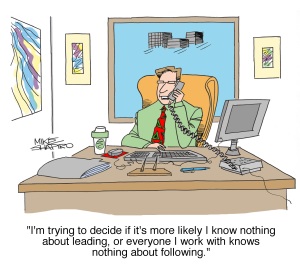 Joe Kavcar was my boss in my first “big girl” job- a sales assignment for a consumer goods company. I was in my twenties and didn’t know much; Joe was in his fifties and knew a lot. It was a pretty good deal for me.
Joe Kavcar was my boss in my first “big girl” job- a sales assignment for a consumer goods company. I was in my twenties and didn’t know much; Joe was in his fifties and knew a lot. It was a pretty good deal for me.
Like all new reps in our division, I started in “Joe School.” Joe connected with his group of newbies. He seemed to understand that people wanted to do well, but just didn’t know how. So he shared his vast knowledge and experience, patiently observed presentations, offered support, and reviewed results with loads of feedback. Still, Joe wasn’t a softie. More than once, I recall him peering over glasses perched at the end of his nose to proclaim, “This isn’t good, Sue.” Joe was demanding, but never mean or petty. He didn’t motivate by either the carrot or the stick, but by his interest in my success. I left Joe School confident, inspired and prepared.
Leaders Like Joe
Joe wasn’t much for labels, so he probably didn’t know he was a generative leader. A concept first described by Eric Erickson in 1950, generativity is behavior that invests in and guides members of future generations. This is in contrast to stagnation, or caring only for oneself. Common sense and considerable research shows that generative leaders make a difference to organizational performance. Time after time, personal experience and research data align to tell the same story: generative leadership practices can lead to employees that are happier in their jobs, perform better and are more excited about their work assignments. These attributes produce outcomes most organizations say they want: greater organizational commitment, increased organizational citizenship behaviors, and in at least one study, increased effectiveness in innovation.
One method researchers use to measure generative leadership is through examining perceptions of followers, specifically follower perception of leadership effectiveness, satisfaction with the leader and follower extra effort. Generative leadership, at its core, fosters sustainable results through others. Sustainable results come through willing, not coerced, followers. So, measure the attitudes and effort of followers to find generative leaders.
What Do We Expect?
If followers determine the effectiveness of leaders through generative behavior, what do followers expect in the first place? Interesting research released last year from Germany by Hannes Zacher, Thomas Henning, Kathrin Rosing and Michael Frese tested several hypotheses related to this question and added a twist. Does the age of a leader make a difference? Do we expect older leaders, like Joe, to lead differently than younger ones? Do we expect different relationships with older leaders than younger ones? Their research produced very interesting conclusions:
1. Leader generativity mattered most for older leaders. The presence or absence of generative behavior made a difference in the perception of success for older leaders.
Older leaders who demonstrated generative behaviors were more likely perceived to be successful by followers than older leaders who did not.
2. Leader generativity did not correlate to success for younger leaders. Followers evaluated the success of younger leaders independently of their generative behaviors. In other words, younger leaders could be viewed as successful even if they were invested in their own careers rather than the success of their followers.
Is This True?
Like all good researchers, Zacher, Henning, et al. describe the limitations of their study, conducted in an academic setting with professors and their assigned research assistants. They do not suggest they have discovered universal truths. But, they do cite that their conclusions support the results of at least two other studies. Zacher, Henning, et al. hypothesize that older leaders are expected to care less about advancing their careers and care more about advancing careers of their followers. Younger leaders, on the other hand, are expected to be more invested in advancing their own careers.
Do you find this to be true in your experience? Do we give younger leaders a pass on good leadership practices? If we believe generative behaviors produce desired outcomes for the followers, leaders and the organization – why don’t we expect them from every leader, regardless of their age?
How We Got Here
I suppose one argument is that older leaders who are perceived to be successful have learned the hard way that the only way to sustainable success is through generative behavior. They’ve learned that they can’t do it alone. We may also expect that at some point, leaders get it, so we have less patience with those who don’t. These are the older leaders perceived to be unsuccessful in the study.
If these conclusions are true for your organization, how do you stop the cycle? What if right from the start of leading others, new leaders were expected to shift their values from promoting themselves to developing others? What if these expectations came not only from those more senior to them, but those who followed? One might wonder if some leaders, unsuccessful in later years, could have been be different if they had not gotten a pass earlier in their careers?
Start Early
In closing, I’ll make an appeal from a (cough) “older” leader. If you are a new leader, develop good leadership practices early. Be a generative leader, whether those you lead expect it or not. Your success will ultimately rest with the willingness of others to follow you. You will learn this eventually, but my hope is that you benefit from this insight the start.
As a leader at any age, be someone’s Joe.
References
Zacher, H., Rosing, K. Henning, T., Frese, M. (2011). Establishing the Next Generation at Work: Leader Generativity as a Moderator of Relationships between Leader Age, Leader-member Exchange and Leadership Success. Psychology and Aging, vol. 26, p. 241-252.







